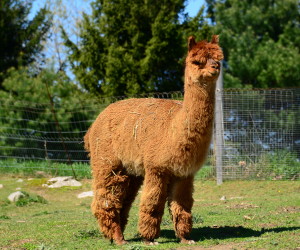 Often we, as consumers, buy things without knowing where exactly they came from. Sure, we can take a quick glance at the tag and determine what country it was manufactured in, but we don’t know much beyond that. Fortunately, with alpaca goods, things are a little easier to visualize. While you may not know exactly what farm the fiber in your scarf or sweater came from, you can still picture a herd of alpacas grazing somewhere on a pasture, their fiber growing into an increasingly luxurious commodity with each passing day. But even though you’re aware of where the fiber in your items may originate, how exactly does it move from the animal grazing in the pasture to the soft material that keeps you warm in the dead of winter? Click through to find out!
Often we, as consumers, buy things without knowing where exactly they came from. Sure, we can take a quick glance at the tag and determine what country it was manufactured in, but we don’t know much beyond that. Fortunately, with alpaca goods, things are a little easier to visualize. While you may not know exactly what farm the fiber in your scarf or sweater came from, you can still picture a herd of alpacas grazing somewhere on a pasture, their fiber growing into an increasingly luxurious commodity with each passing day. But even though you’re aware of where the fiber in your items may originate, how exactly does it move from the animal grazing in the pasture to the soft material that keeps you warm in the dead of winter? Click through to find out!
Step 1 – Shearing:
Alpacas have some of the most premium fiber in the world. The natural fiber grown by alpacas is called fleece, and has the ability to be light or heavy, depending on how it is spun. Left unattended, alpaca fleece could grow long enough to touch the ground after just a few years. For the most part, in North America, alpacas are sheared once a year, usually in the spring. At our farm – Abbott Farms in Cumberland, Maine – our animals are sheared in May to make sure that they will stay cool in the summer months.
Step 2 – Skirting:
Once sheared, the fleece must be checked for bad pieces. This process is called skirting. Basically, any pieces that are too short or too coarse to be spun into a high quality yarn are removed before the fiber can be sent to local spinners. Pieces of hay or food that may have been caught in the alpaca’s fleece are also removed during the skirting process.
Step 3 – Spinning:
The skirted fiber is sent to local spinners who spin it into yarn. The method of spinning is dependent on the individual spinner, but the end result is the same: a premium yarn that is then used to make the wonderful alpaca products found in our store. Fiber that has been skirted and spun can also be dyed into various colors, depending on the needs and wants of the weavers, knitters and crocheters.
Step 4 – Creating:
Once the spun yarn is finished, it is sent to local weavers, knitters and crocheters who make scarves, blankets, sweaters, vests, hats, mittens, socks, and other great items. Alpaca fiber, once spun into yarn, is used just the same as wool or other yarns, and can be made into a slew of different products.
Step 5 – Enjoying:
Here at PacaNaturals, we are committed to selling the most premium of these alpaca goods. Our selection is vast, and our customers are guaranteed to find something they love. Our products have all been through the process you’ve just read about, and are sure to be unique. Alpaca products are as durable as they are beautiful, and will be keeping you warm for years to come.
